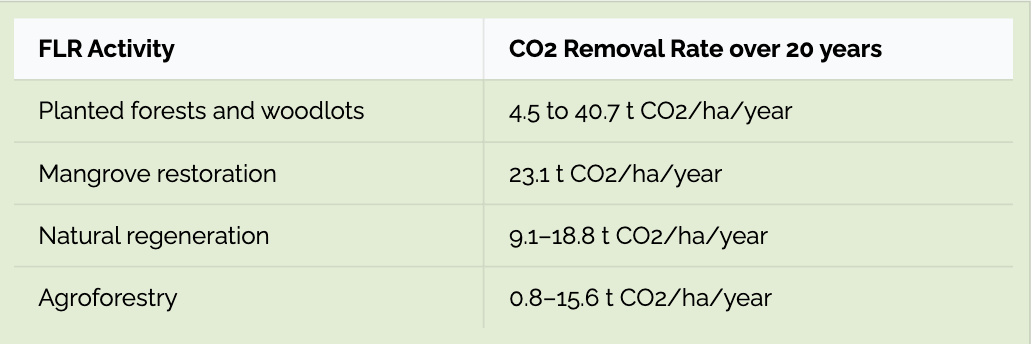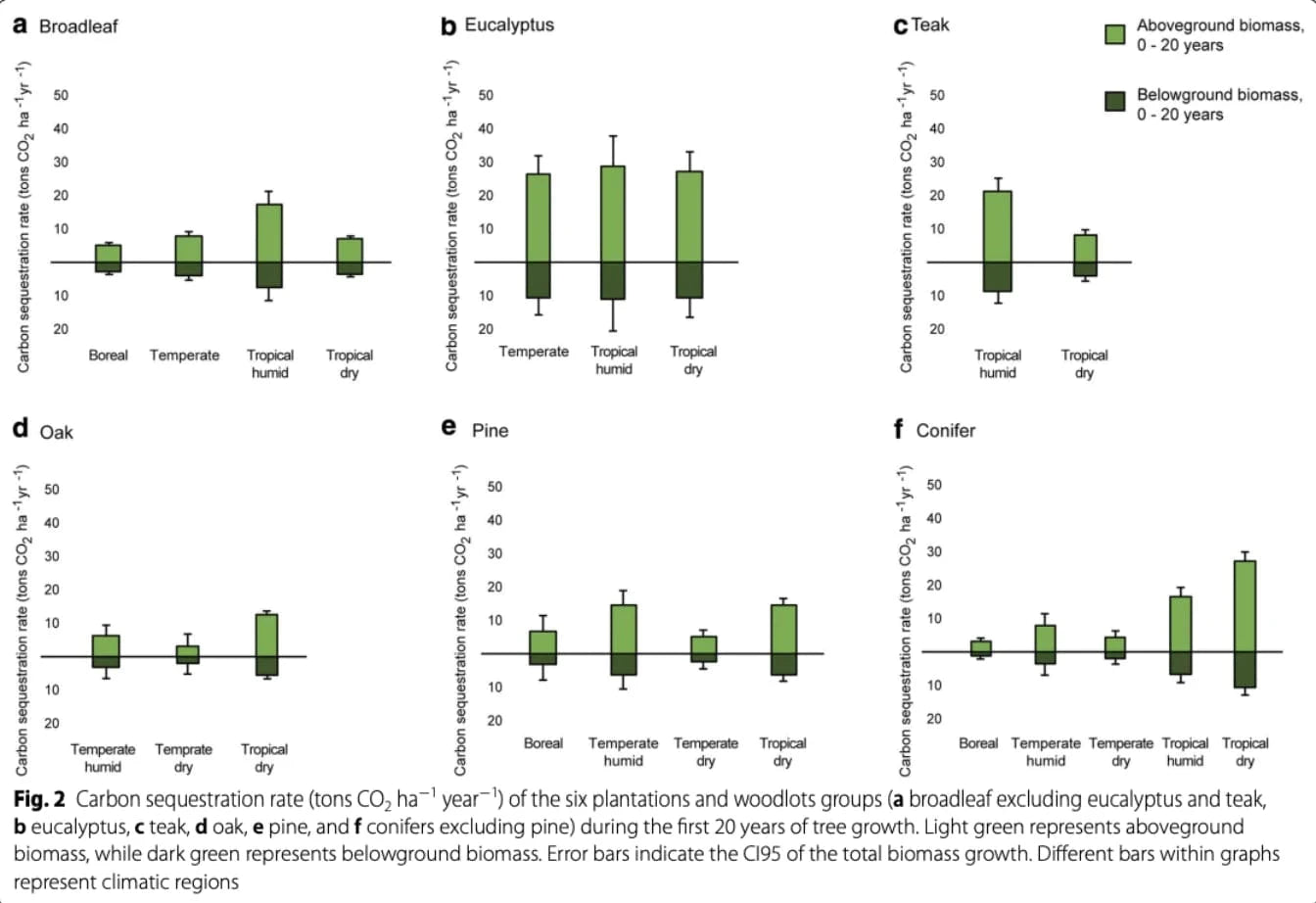
Get news, updates, & event Info delivered right to your inbox:
How Much CO2 Does a Tree Absorb?
It’s the question everyone is asking as we move toward a Net Zero by 2050 future. In short, although a lot has been written about carbon capture and storage, and about utilizing tree planting to reach netzero goals, the answer is complicated. Searching for this question on Google gets you a range of values with over 18,000 hits directly referencing "48 pounds of carbon dioxide." The majority of these are a variation of the following sentence: “During one year, a mature tree will absorb more than 48 pounds of carbon dioxide from the atmosphere” It is great to have it quantified, but where is the evidence?
I’m a Forestry Specialist at One Tree Planted, providing technical support and science-based evaluations for our projects, so I value credible peer-reviewed science and data when it comes to metrics of any kind. I searched for the science supporting the 48 pounds per tree per year claim and came up empty handed.
Many of the articles simply cite one another, leading nowhere. At the root of the claim seems to be this article published by the European Environment Agency which suggests “Over one year a mature tree will take up about 22 kilograms [or 48 pounds] of carbon dioxide from the atmosphere, and in exchange release oxygen.” But even this article does not cite any tree-based carbon studies. As a field, we should not be relying on such limited evidence for such a ubiquitous claim.
We can do better. Donors and partners that are working to reduce their carbon footprint often ask One Tree Planted how much carbon dioxide their donation of trees will absorb. It’s a great question, but unfortunately the answer is complex.
Carbon Absorption is Related to Tree Growth and There Are Many Factors That Affect How a Tree Grows.
The Main Tree Growth Factors Are:
- Tree Growth
- Location
- Growing Conditions
- Water Availability
- Sunlight
- Local Climate
- Soil Nutrients
- Site Specific Factors
Trees growing in favorable conditions can grow extremely rapidly, while trees growing in suboptimal environments grow slowly.
How is the Amount of Carbon Dioxide Absorbed by Trees Calculated?
It’s important to consider the many factors involved in estimating the rate by which a tree can absorb carbon dioxide. Even though it comes with many caveats, it is possible and helpful to provide a ballpark figure so we understand the order of magnitude of the relationship between a tree and carbon dioxide absorption.
One Tree Planted’s Methodology to Calculate Carbon Sequestration
Our methodology is based on the Winrock International Forest Landscape Restoration (FLR) Carbon Storage Calculator. It applies data from the Global Removals Database developed by Winrock International under funding from the International Union for Conservation of Nature (IUCN). This review collated data on the biomass accumulation rates for a set of FLR activities (natural regeneration, planted forests and woodlots, agroforestry, and mangrove restoration) across the globe and global CO2 removal rates. Their review is derived from data on biomass accumulation from over 330 published studies and reports. The outputs and results of the study show CO2 removal rates during the first 20 years of growth after restoration activities (Table 1).

So what does this mean, and what does it mean for a tree?
The results here are saying that there is a range between 4.5 and 40.7 tons of Carbon Dioxide removed per year per hectare during the first 20 years of tree growth. The rate of removal depends on the location and type of forest and the statistic is measured on an area basis rather than a tree basis. This is a good approach. Forests are composed of many types of trees. Furthermore, the initial trees planted during a restoration project may not be the same trees present 20 years later - some trees will die naturally, and some trees will regenerate naturally from seed in the soil or brought in by the wind or by animals. This is a natural process.
This chart from the Bernal Review summarizes the range of values observed by tree species and by region:

How Much Carbon Dioxide Do Trees Absorb Per Year?
To determine the amount of carbon dioxide a tree can absorb, we combine average planting densities with a conservative estimate of carbon per hectare to estimate that the average tree absorbs an average of 10 kilograms, or 22 pounds, of carbon dioxide per year for the first 20 years. This was determined by reviewing the planting density of our projects around the world, with an average planting density rate of 1,000/trees per hectare.
With carbon estimates, we like to err on the side of being conservative to avoid over inflating the potential benefits, which is why we selected 10 tons per hectare per year. Dividing 10 tons per hectare by 1,000 trees per hectare gets us an average value of 10 kilograms/22 pounds per tree per year. This is a little less than half of the commonly cited 48 pounds per tree per year, which gives us confidence that we are in the same ballpark as the accepted, de facto number, but are now being more conservative, and have a way to back it up.
There are verifiable carbon accounting methodologies that we fully support, like the Gold standard. These are often only suitable for large projects, and require additional costs and processes that are not applicable to all projects. The 10 kilograms per year is meant as a starting estimate to help us understand the potential carbon impact on a per tree basis.
It’s important to remember that the true benefits of trees and healthy forests go far beyond carbon storage. Their value for biodiversity, social impact, and the stability of the global climate are well documented. This may also be a challenge to measure, but at the end of the day, the need to protect and restore our forests by planting trees is essential.
Want to help us protect and restore our forests? Plant trees today!
Get news, updates, & event Info delivered right to your inbox:
Related Posts
Why Trees Are Great Holiday Gifts
04/12/2025 by Meaghan Weeden
Real vs. Fake Christmas Trees: Which is Better For the Environment?
20/11/2025 by Meaghan Weeden
8 Reasons to be Grateful for Trees This Thanksgiving
18/11/2025 by Meaghan Weeden
Popular On One Tree Planted
What Causes Deforestation?
10/07/2025 by Meaghan Weeden
8 Amazing Bamboo Facts
14/01/2025 by Meaghan Weeden
Inspirational Quotes About Trees
09/01/2025 by Meaghan Weeden
Fundraising Disclosures

Be Part of the
Restoration Movement
The Grove is more than just a monthly giving program: it's a vibrant community of individuals who are dedicated to reforestation and environmental restoration on a global scale.
As a member of The Grove, you affirm your commitment to restoring forests, nurturing biodiversity, and fostering positive global change.





